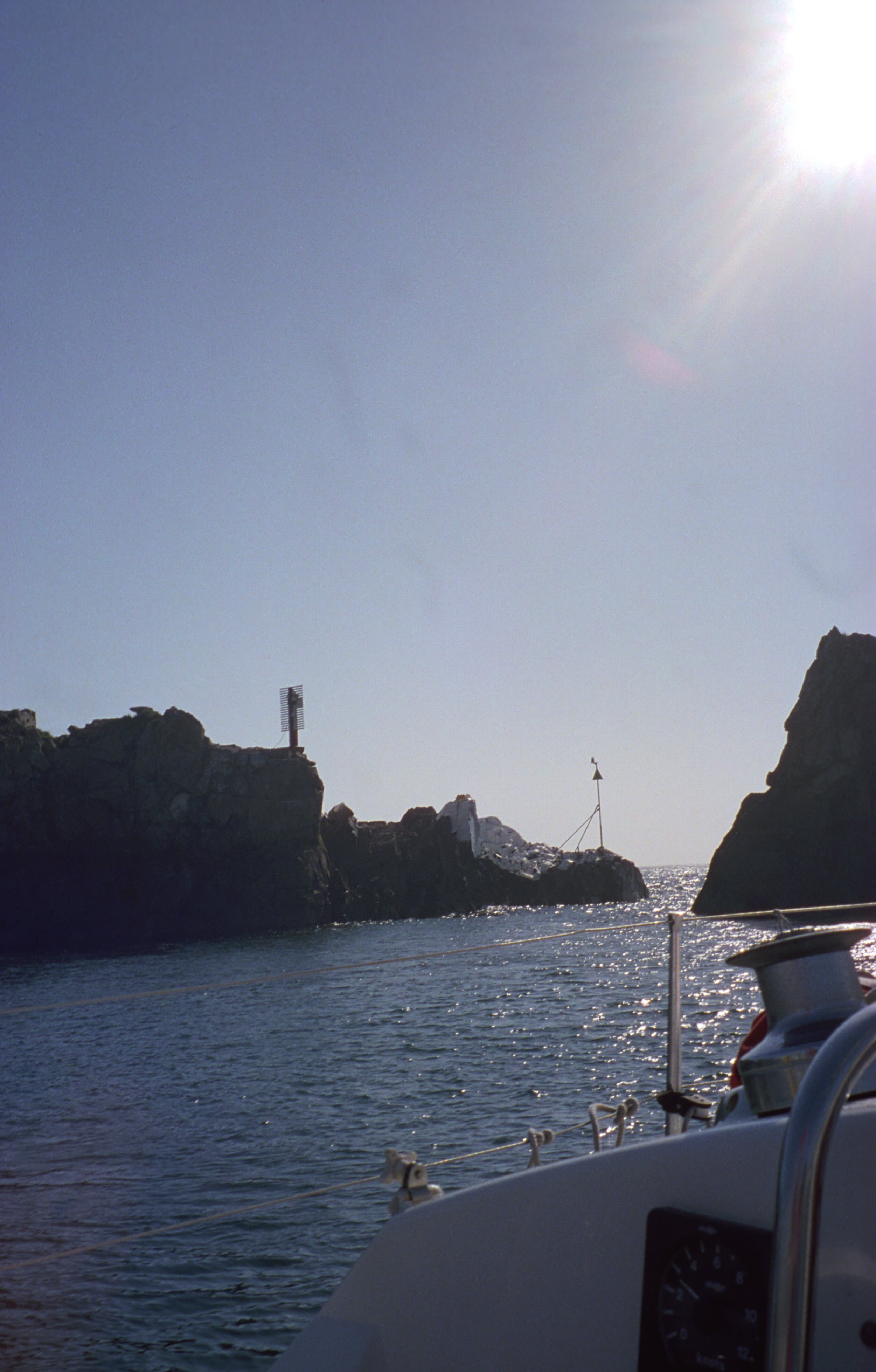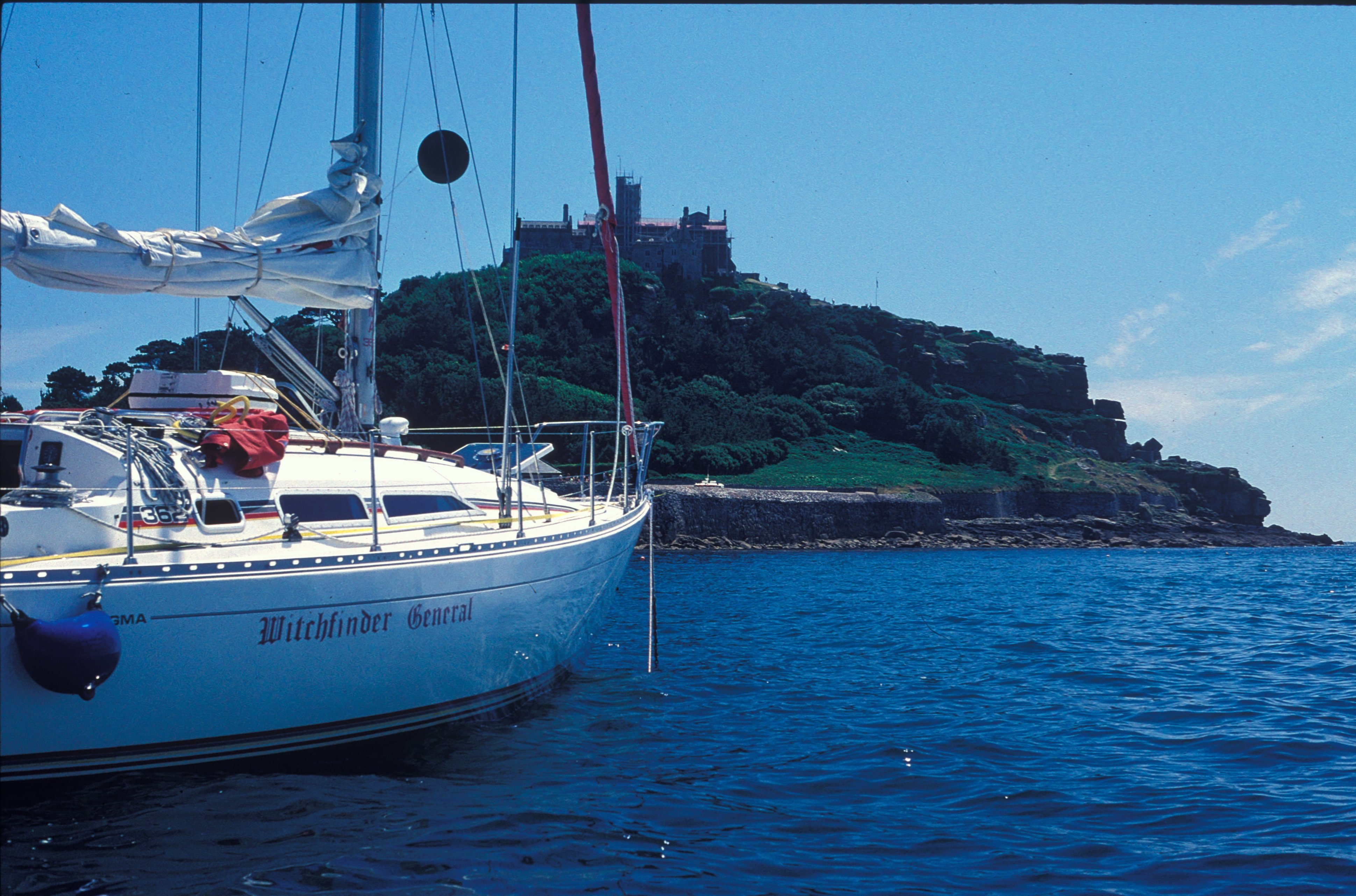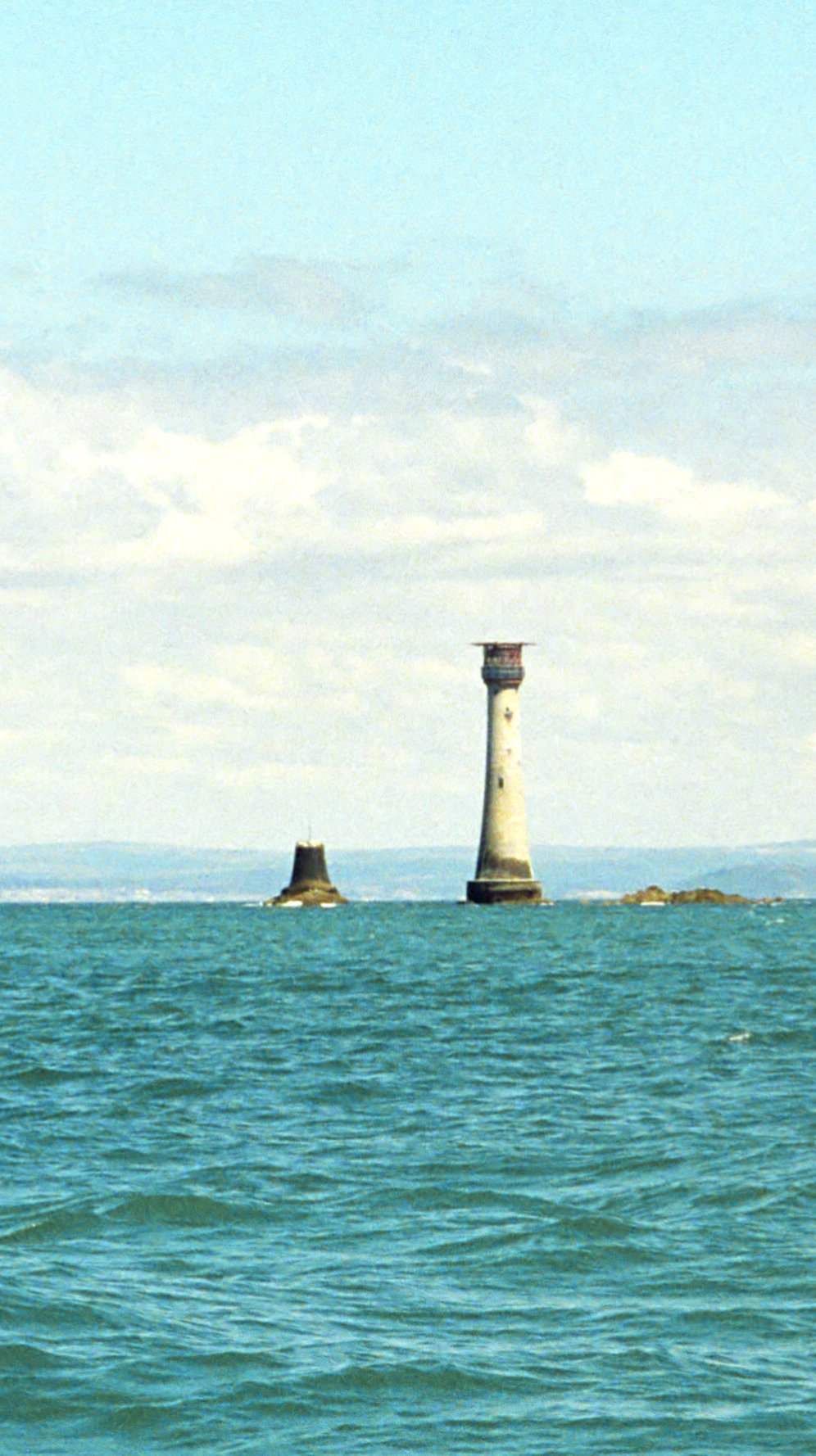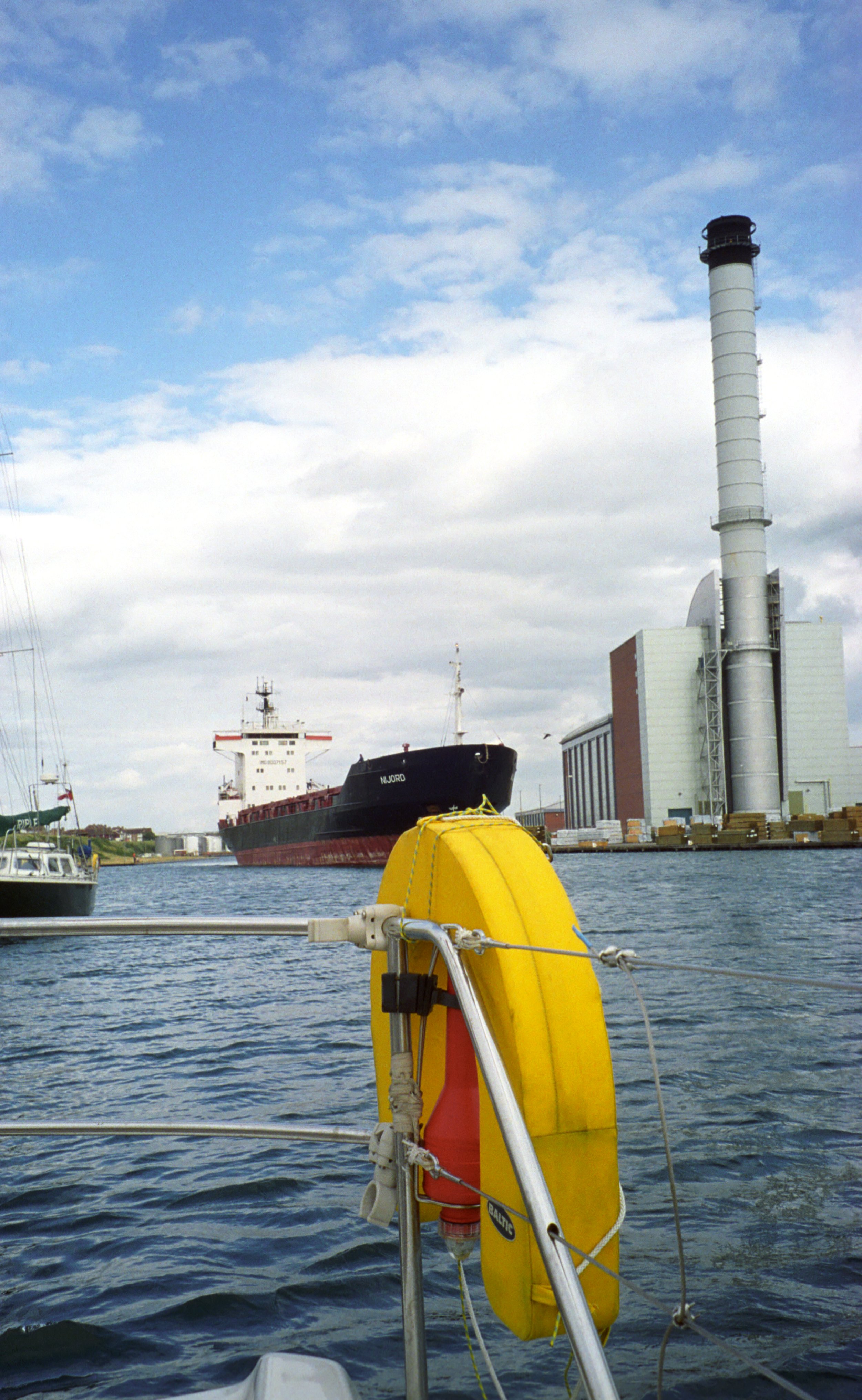In which Witchfinder has three glorious weeks with moderate winds and one with winds verging on too strong, hosts a hitch-hiking pigeon, boxes the western Channel, and gets an unsolicited visit from a lifeboat.
As in the past few years we had four weeks for our summer cruise. We wanted to get as far as possible to the west of Brittany and maybe round to the south in about a week, have a week as “holiday”, then take a couple of weeks getting back. To help with the up-hill, down-channel slog we took a couple of crew, work-mates of Peter’s, for the first week. We slipped out the Tidemill just as darkness was falling. To get out of the Deben in one tide would have meant a slightly nerve-racking after-dark dash from the Tidemill to Felixstowe Ferry and then a crossing of the bar, again after dark, on a falling tide. This trip we saved our nerves and took our time and anchored at the Rocks, halfway down the river, for an early start the next day. Turning south, outside all the sandbanks had us heading into a rising southerly wind. Some mutinous murmurings from the crew about Oostend having good restaurants and being a cross-tide reach were quickly squashed. However, by the time we were halfway across the Thames we all decided that heading a force 5 in wind-over-tide round North Foreland was not an ideal first day activity so we anchored in relative shelter tucked in close in front of Margate.
Next morning it was still blowing but we needed to get on so we waited for slack tide and beat around North Foreland in relative comfort.
By the time we got to Dover the tide was running hard again and we were back into wind over tide. Although we had only made 20 miles we ducked into Dover. By now the wind was up to about 25 - 28 kt and the seas in Dover entrance were confused to say the least. Port control were, as always, polite, good humored and accommodating when we asked,
“Permission to enter Eastern, in the centre, quite fast, and now, please”
They came back straight away,
“The green lights are yours, sir. The ferry will wait”
We were nearly 24 hrs anchored in Dover before we got away, due in part to a persistent false alarm on the engine control panel. We made up part of this slippage by pushing on non-stop to Poole, and getting the tide timing dead right for Beachy Head, the Looe off Selsey Bill, and St Catherine’s Point. One of our crew had always known that a job interview might curtail his trip, and sure enough he got a text saying he had indeed been called. To give us maximum flexibility later on we dropped both the crew off early, at Poole, with many thanks for generously helping us over the uphill part of the trip. Jenny and I were on our own.
We spent the night in the over-priced noisy Poole Town Quay Marina and crossed to Alderney later the next day arriving before dawn. As we awoke in Bray harbour, to clear in with one of the youthful immigration officers they have there, the forecast upgraded the north easterly to a strong wind. This wind would make our current anchorage untenable and the route to our destination, the already scary north coast of Brittany, a lee shore. Against all taste and judgment we headed to Guernsey to sit it out. Determined not to revisit the hell-hole that is St Peter Port in high summer we tried Beaucette. What a surprise and what a delight. The almanacs all seem to be hung up on Beaucette being a old quarry. Well, yes, it was, but now the walls are covered in trailing plants and the water is deep and clear; it’s in the wildest and most unspoiled part of Guernsey with walks right off the pontoon; and it has a wonderful restaurant. We stayed 3 days which, for us is a long stay. We walked into St Peter Port (hell-hole maybe, but it does have an M & S food shop) in about and hour and a half and bussed back in 10 minutes on one of the two-an-hour buses. The Beaucette harbour master was quite right when he said “we are Guernsey’s best kept secret”.

Baucette entrance is very deep, but very narrow
A 24 hour run from Guernsey along the Brittany north coast was enlivened when a pigeon joined us. We were well out of sight of land when it alighted on the coach roof. It was exhausted and barely made it back to the boat when we tried to encourage it to leave (i.e. threw it off the boat). We resisted feeding since this might be interpreted as adoption but we did offer a dish of water, which it stood in and slurped up. It then fluffed up and went to sleep. As we passed L’Aber-Wrac’h we were able to raise my sister on the VHF. She and her husband are cruising slowly down the French coast. They came out and followed us round to L’Aber-Ildut where we shared a mooring. The prospect of meeting my sister was too much for the pigeon, which left at about this time. L’Aber-Ildut is a place we will return to when we have more time. It has good moorings; a restaurant; and a harbour master who will deliver basic shopping to the boat. This is the centre of the sea-weed industry. Specially built boats, resembling small landing craft, with vicious looking grabs for wrenching sea-weed off rocks, arrive at carefully timed intervals to rendezvous with big trucks (picture sugar-beet lorries or grain haulers). Apparently, the business was nearly dead when demand for organic sources of iodine came along to revive it.
By now we were coming to the end of our “traveling out” phase and starting to think about where we could put in for our week long “holiday” phase. In short we were getting a little worn out! We know Morgat well and like it, but the somewhat closer, if not so nice Camaret, just across Brest roads, beckoned. The phrase in the almanac “Morgat is small and often full” was the clincher, and so we had our holiday in Camaret. Actually, when we went to Morgat on the bus for a day trip it turned out to be nowhere near full and every bit as nice as we remember: make a note for next year.
Rested after a week’s holiday we said farewell to sister and brother in law and turned the Witchfinder north, back through the Chenal du four, between mainland France and Ushant, towards West Cornwall. There was quite a big swell rolling into the western channel although in modest winds the crossing was not uncomfortable. I had not realised how difficult it would be to set the sails properly in a swell; do you set them for the crest, or for the trough? A long almost moonless night with spectacular phosphorescence and the Lizard light winking at us put us in the right frame of mind for a Marie Celest moment, which came when the collision alarm went off for very large passenger ship five or six miles off. It claimed to be called Normandie, which was destroyed in a tragic fire in 1942. Anyhow the ghostly hands on its wheel changed course a few degrees to give way and pass majestically behind us. The swell fell away steadily as we entered Mount’s Bay an hour before dawn. We identified St Michael’s Mount as a black hole: darker than the surrounding shoreline because of its uninhabited, tree-clad south side. We fetched up in the anchorage outside the tiny harbour on the Mount in the dawn gloom, with the sound of

Off St Michael's Mount
breakers to remind us of the Great Hougus rocks a hundred metres away. Coming up after a few hours sleep was like waking up in a picture post card. We had the Mount, with its tiny picturesque harbour and fairy-tale castle behind us, and Marazion and the 3 mile sweep of beach around to Penzance 300 m in front. This was like coming home for me. Although I grew up in London, as a child I spent long periods each summer staying with relatives in Penzance and I know this small area very well indeed.
All too quickly we needed to leave, and there was no good tidal solution from Marazion round the Lizard to Falmouth at the times we needed so it took forever. Falmouth was a find. Good places to eat; a well run visitors marina; a launderette that does service washes with collection and delivery to the pontoon and ice from the off-licence that stays open until 2300; we could live there!
Next stop Weymouth, passing close enough to the Eddystone Rock to get some pictures.

Passing Eddystone Rock, as close as we dared go
This was a wonderful sail: a fast broad reach all the way including around the inside passage at Portland Bill (a first for us), although we did not expect the fluky (and very strong) wind eddies on the lee side of the Bill and were caught with way too much sail up and not a lot of sea room to round up. Suffice to say that we can now reef the mainsail quite quickly without having to round up! My mother lives in a care home in Weymouth and we took the opportunity to visit her.
Our arriving by boat puzzled her somewhat, when the conversation did not start in the time honoured way with me moaning about traffic on the M25 and M27. At about this point in the trip the winds turned west and started to blow. As we were leaving Weymouth we discovered it was Cowes Week which, for us, ruled out the Solent. We would rather take our chances with the race off St Catherine’s with quite a strong tide against us and F5 – 6 behind us. The tide was either going to be wrong at St Alban’s or at St Cats and we chose the latter. It turns out the race goes well to the south and well to the east. I know that now! We must have been in race-y water for nearly 3 hours. Still, better that than the Solent in Cowes Week. By the time we were out of the races the tide was turning fair but we did not feel up to the Looe channel, with the tide pushing us and on a dead run, so we anchored off Bembridge. Next morning we still had F5 – 6 westerly and ran with the tide through the Looe channel at about 9 kt over the ground. I would never have even considered this back in the days before electronic navigation. The buoys are tiny and only become visible less than mile away and mark a fair channel 200m wide with hazards on both sides. A boat in the wrong place would have no way back against wind and tide.

The Great Chimney of Shoreham - nearly home now...
A very quick trip put us into Shoreham having covered 35 nautical miles over the ground in 5 hours, sailing all the way in wonderful sunshine. We walked from Shoreham to Brighton along the seafront to get back our circulation after a couple of days cooped up on the boat. We set off to do the Shoreham to Dover leg in one tide, but with tail winds rising to steady F6 and gusts of F7 we were ready to stop by the time we rounded Dungeness, in really very big seas. We turned north and anchored in the lee east of Dungeness.
When we made our routine “safe arrival” call to the Coastguard they seemed to get the feeling that all was not well. It’s always a bad sign when the coastguard offers to read you back the weather forecast without you asking! Certainly the forecast had 6s and 7s in it, but we were safely anchored on heavy tackle close under a weather shore and by now had dinner on the go so I reassured them, or so I thought, that all was well and got on with our dinner. A little while later I glimpsed a RIB through the open companionway and went up to look, wondering what fool would be out in this weather in a RIB. We were being eyed up by the Inshore Lifeboat.
“Are you planning to stay the night, sir?” They hollered thorough the wind, looking slightly quizzically at me, although not quite in carpet slippers and smoking jacket, now without my foul weather gear on.
“Well, yes” I replied.
“There is more water further up towards the Mulberry”, they shouted, pointing north.
Although I had done my tidal height sums carefully with a view to getting in as close to the weather shore as possible and was in precisely the right depth of water, I have a rule that I don’t argue with on-duty lifeboat coxswains so I said we would move after dinner. They stood off and looked as if they were going to stay put until we moved so we postponed dinner, upped the anchor and moved to the indicated spot. Satisfied, the lifeboat sped off. I didn’t discover who put them on to us.
24 hours later, still with strong wind warnings in the weather. By now we were getting fed up with bobbing about at anchor in the middle of nowhere, and getting lethargic from sleeping and eating too much, so we waited for a lull and headed for Dover. The lull, inevitably, was short lived so we got to Dover very quickly, and entered again in 28 kt of wind and confused seas, this time with the added excitement of being half-blinded every seven and a half seconds by the pier head lighthouse. The anchorage in Dover is sheltered and we slept soundly.
Now we just wanted to get home. Headwinds meant motoring more or less all the way, and we made little headway in the choppy water. A screw-up in our departure time saw us arriving too early and having to anchor a few hundred metres off Felixstowe beach in the early
hours of Saturday morning to wait for water at the Ferry. It was here I discovered that I had left unfastened one of the fore cabin hatch clips and everything in there was soaked. It was definitely time for home but we had to wait out one more tide at Bawdsey for enough water at the Tidemill.
This was the Witchfinder’s best cruise yet with wonderful sailing and a wonderful holiday. We know the boat won’t let us down. Many lessons were learnt: we will stage the boat to Shoreham or Weymouth a week or two before next year’s trip; the autopilot while safe, gives a very uncomfortable ride running before stiff winds and biggish following seas – this in turn shortens our endurance quite a bit because someone has to hand steer; and finally; always check the hatch clips are secure!